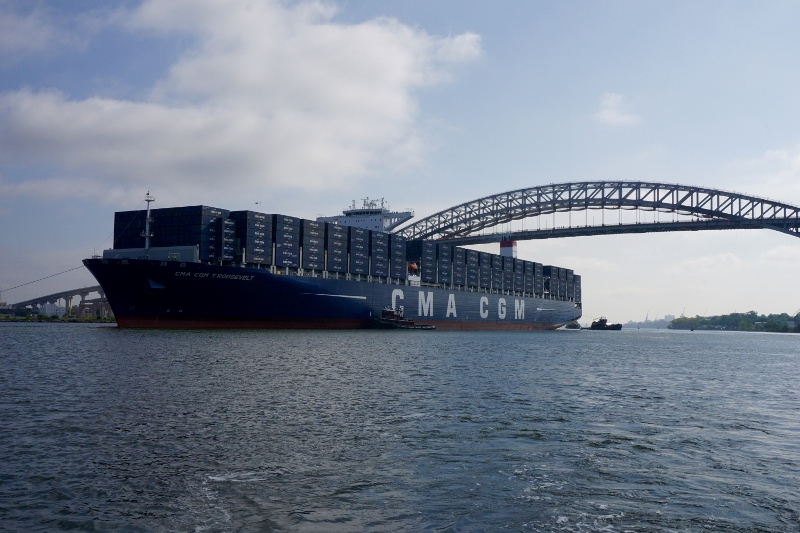The crowd along the shore at Dennis Collins Park clicked away on their cameras and smartphones as they watched a ship almost as long as the Empire State Building is tall motor past.
On its first arrival passing Bayonne, N.J., the CMA CGM Theodore Roosevelt seemed to fill the Kill Van Kull channel between the park and Staten Island, N.Y.
At 1,200’x152’x55’, the Roosevelt has a container capacity of 14,414 TEUs, the largest yet to call at the New Jersey cargo terminals. To get it there, the Port Authority of New York and New Jersey and its public agency partners needed billions of investment dollars to deepen the harbor channels to 50’, and raised the Bayonne Bridge by 64.’
The Roosevelt’s transit was a culmination of almost 30 years of effort to expand the port’s capacity – and a signal that nearly a decade after the great financial meltdown of 2008, Americans are buying more imports.
Just after 9:30 a.m. on Sept. 7, the Roosevelt glided under, clearing the new 215’-high road deck by 30’. Before the $1.6 billion bridge project, ships larger than 9,000 TEUs could not reach the New Jersey container terminals at Elizabeth and Newark, a hub of trade in the northeastern U.S.

The containership CMA CGM T. Roosevelt passes under the 215'-high Bayonne Bridge with 30' to spare on Sept. 7. Kirk Moore photo.
Years before work began to widen the Panama Canal, U.S. port industries saw this coming, and began to prepare. Allies in industry, labor and politics lined up federal funding for the Corps of Engineers to deepen channels in East Coast ports.
At the port of New York and New Jersey, environmental, tourism and fishing advocates weighed in too, demanding in the 1990s that harbor sediments loaded with pollutants from the past century of chemical manufacturing be cleaned up, not just dumped in the ocean.
That project took 20 years, officially completed in summer 2016, just weeks after a newly finished set of locks on the Panama Canal widened by 70’ permitted the passage of a first containership with 158’ beam.
With the U.S. economy growing again, those investments are seeing returns.
Separated by thousands of miles, all those navigation projects and infrastructure were needed for bringing the new generation of ships from Asia to the U.S. East Coast, said Marc Bourdon, president of Marseille, France-based CMA CGM.
“Without the bridge being raised, meeting the growth requirements of the region would have been a challenge,” said Bourdon. New York-New Jersey takes in 56% of the trade volume for the U.S. East Coast, so it is a “cornerstone of any service deployment, particularly from Asia,” he said.
It was the maiden voyage of the Roosevelt, the first in a class of six ships to be built for CMA CGM. The ships will make regular Saturday port calls at Port Elizabeth, close to where containerized shipping got its start in 1956.
There is plenty of speculation about how the new routes for bigger ships will affect trade coming to the U.S. West Coast. But Bourdon does not see a downside for Pacific ports.
“It’s not going to be at the expense of the West Coast. The market is growing,” he said.
That same week officials at the Port of Long Beach, Calif., said pretty much the same. Imports there jumped 10% in August over the year before, the third-highest monthly total in the 106-year history of the port. It was the second-busiest August ever and the third-highest container volume for any month, said port officials, who consumer demand and retailer optimism over coming holiday sales.
“The modest economic growth we’ve seen since the Great Recession has been replaced this year by robust gains, at least when measured by goods coming into the United States,” said Mario Cordero, the port’s executive director.
Meanwhile, exports trended downward, with 117,290 outbound containers loaded onto ships, a 26.3% decrease due to shifts in vessel alliances, according to Long Beach tallies. Empty containers going back to Asia to be refilled with goods climbed to 219,370 TEUs, a 37% increase.





